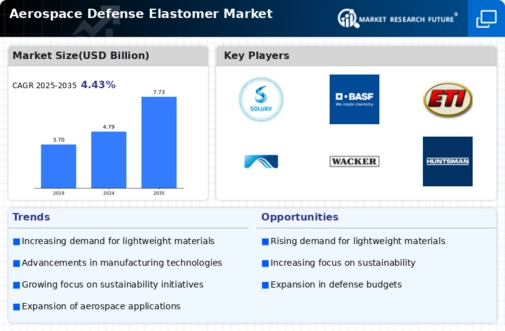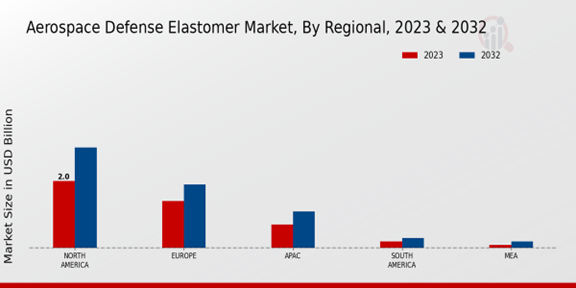Increasing Defense Budgets
The Global Aerospace Defense Elastomer Market Industry is experiencing growth driven by rising defense budgets across various nations. Countries are prioritizing modernization and procurement of advanced military equipment, which necessitates the use of high-performance elastomers. For instance, the United States has allocated substantial funds for defense spending, which is projected to reach 4.79 USD Billion in 2024. This increase in budgetary allocations is likely to enhance the demand for elastomers that can withstand extreme conditions, thereby propelling the market forward.
Increased Focus on Sustainability
Sustainability initiatives are becoming increasingly important within the Global Aerospace Defense Elastomer Market Industry. Manufacturers are exploring eco-friendly elastomer options that minimize environmental impact while maintaining performance standards. This shift towards sustainable materials is driven by regulatory pressures and consumer demand for greener solutions. As a result, companies are investing in research and development to create bio-based elastomers that align with sustainability goals. This trend not only enhances the market's appeal but also positions it favorably for future growth as environmental considerations become paramount.
Expansion of Aerospace Applications
The diversification of aerospace applications is a significant driver for the Global Aerospace Defense Elastomer Market Industry. As the aerospace sector evolves, elastomers are increasingly utilized in various components, including seals, gaskets, and insulation materials. This expansion is fueled by the growing need for reliable and durable materials that can withstand harsh operational environments. The increasing integration of elastomers in both military and commercial aerospace applications is likely to bolster market growth, as manufacturers seek to enhance the performance and longevity of their products.
Technological Advancements in Materials
Innovations in material science are significantly influencing the Global Aerospace Defense Elastomer Market Industry. The development of advanced elastomers with superior properties, such as enhanced thermal stability and resistance to chemicals, is becoming increasingly prevalent. These advancements enable manufacturers to produce components that meet stringent aerospace standards. For example, the introduction of fluorosilicone elastomers has improved performance in aerospace applications, leading to a projected market growth to 7.73 USD Billion by 2035. Such technological progress is likely to attract investments and drive market expansion.
Growing Demand for Lightweight Materials
The trend towards lightweight materials in aerospace applications is a key driver for the Global Aerospace Defense Elastomer Market Industry. Lightweight elastomers contribute to fuel efficiency and overall performance of aircraft, which is critical in defense operations. As military aircraft manufacturers seek to reduce weight without compromising safety, the demand for specialized elastomers is expected to rise. This shift is anticipated to contribute to a compound annual growth rate of 4.44% from 2025 to 2035, reflecting the industry's commitment to innovation and efficiency.























Leave a Comment